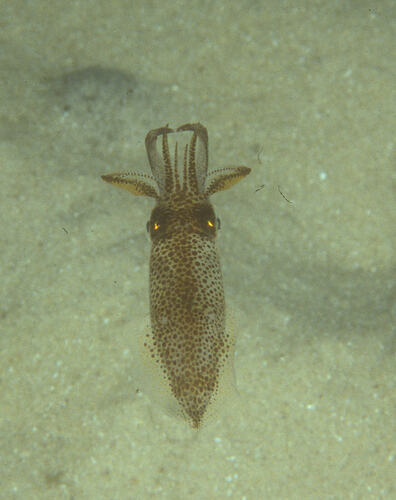General Description
Small squat, cylindrical, free-swimming squid. Two large rounded fins on sides of body encompassing the rear half of its length. Fins joined at rear tip to form overall heart shape. Colour pattern of large black, brown and orange dots (chromatophores) over a transparent background. Mantle length to 9 cm, total length to 13 cm.
Biology
This small squid is very tolerant of low salinities allowing it to forage in estuaries and brackish water. It is most active at night hunting for crustaceans and fish. The common and scientific names of this squid refer to its light-producing abilities (bioluminescence). Within its gill cavity it has two special light organs that contain living bacteria. The bacteria are fed sugars by the squid in return for producing light. The squid uses this light to hide its silhouette when it is swimming around at night. It lets out just enough light to match the background moonlight or starlight, effectively hiding it from fish predators waiting below. Little is known of reproduction in this species. The adult male has a special modified lower left arm where the suckers have been replaced by rows of fingers of skin. This arm may help pass sperm packages to the female or may be used to remove the sperm of previous males. This squid is caught incidentally in inshore trawls, at least in north-east Australia. It can be confused with the juveniles of the larger more commercial squid species. It is short-lived (at least in northern Australia), living only 70 days.
Distribution
Eastern Australia.
Habitat
Shallow coastal habitats particularly around seagrass beds to depths of around 50 m.
More Information
-
Animal Type
-
Animal SubType
-
Brief Id
10 arms and tentacles, large rounded fins joined around tip of body to form heart shape, cylindrical body, black brown and orange spots.
-
Colours
Black, Brown, Transparent
-
Maximum Size
13 cm
-
Habitats
-
Diet
Carnivore
-
Hazards
Potential to bite, especially if handled. Venom status unknown.
-
Endemicity
-
Commercial
Yes
-
Conservation Statuses
CITES: Not listed, FFG Threatened List: Not listed, DSE Advisory List: Not listed, IUCN Red List: Data Deficient
-
Depths
Shallow (1-30 m), Deep ( > 30 m)
-
Water Column Locations
Midwater
-
Taxon Name
-
Scientific Author
(Lu et al., 1985)
-
Common Name
Luminous Bay Squid
-
Phylum
-
Class
-
Subclass
-
Order
-
Suborder
-
Family
-
Genus
-
Subgenus
-
Species Name
noctiluca

